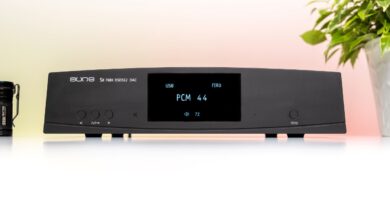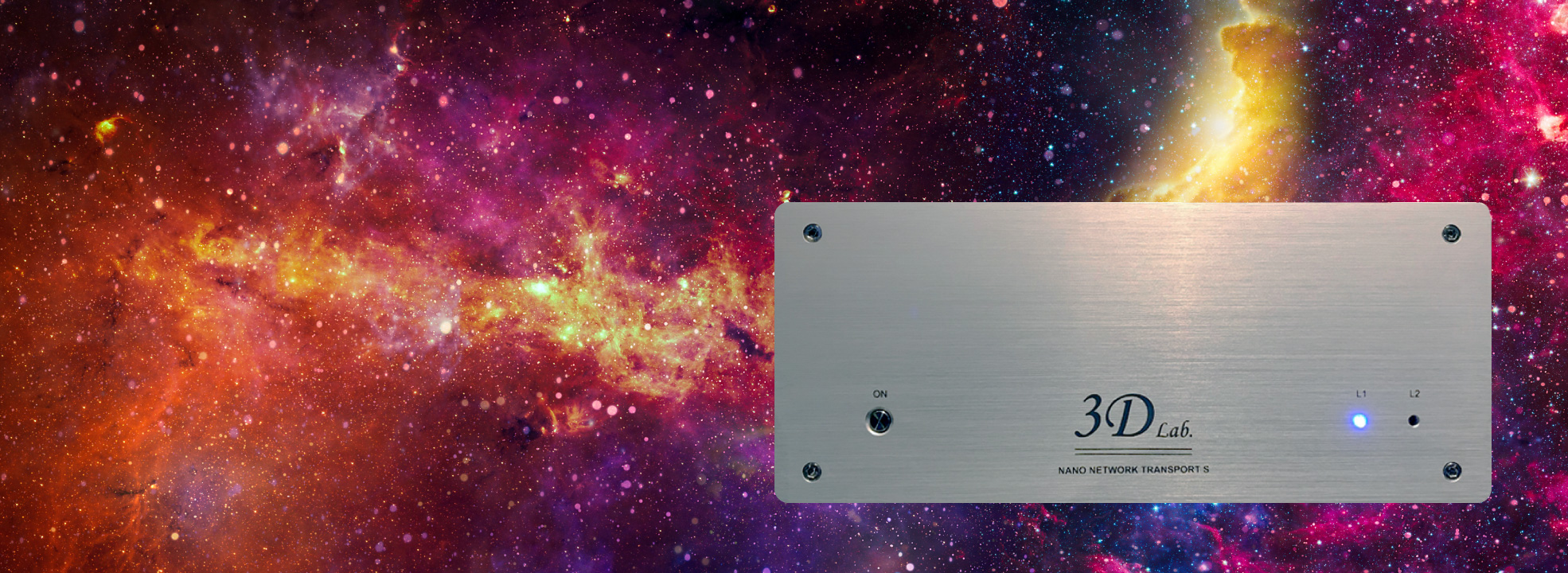
Hello, dear friends. I am trying to tell you a new story today. I recently read an article in Quanta Magazine (www.quantamagazine.org) with an intriguing title, „Does Time Really Flow? New Clues Come From a Century-Old Approach to Math.” I will not pretend to „understand” quantum physics or general relativity. I am just showing off, hunted by the eternal questions of life…
Time.
In physics, the definition of time is simple — time is change or the interval over which change occurs. It is impossible to know that time has passed unless something changes. The amount of time or change is calibrated by comparison with a standard. The SI unit for time is the second, abbreviated – s.
„In Albert Einstein’s theory of relativity, for example, time is woven together with the three dimensions of space, forming a bendy, four-dimensional space-time continuum — a “block universe” encompassing the entire past, present, and future. Einstein’s equations portray everything in the block universe as decided from the beginning; the initial conditions of the cosmos determine what comes later, and surprises do not occur — they only seem to.”
Physicists who think carefully about time show the troubles posed by quantum mechanics (the laws describing the probabilistic behavior of particles) – a particle maintains simultaneous quantum states until you measure it, at which point the particle collapses to just one of the states. This apparent inconsistency between the nature of time in quantum roam and how it behaves in relativity has created a lot of confusion.
The difference has significant implications on the understanding of time, but most of all, on a fundamental question that we, mortals, ask: Is time completely predefined as described by Einstein’s relativity, or is there an unpredictability like in quantum mechanics that in the end will give us „the free will”? In other words, is everything entirely calculable (assuming one knows every detail of every particle and one has the computing power required), or is there room for randomness, an imprecise flow of time, or unpredictability?
Are we, everything surrounding us, the whole universe on a predefined course? That is a terrible question, don’t you think? But, there is a problem with this deterministic picture of time…
A little uncertainty that can free us all.
Sixty-seven years old, Nicolas Gisin runs a lab at the University of Geneva where they performed groundbreaking quantum communication and cryptography experiments.
On Sunday mornings, Gisin habitually sits quietly in his chair at home with a mug of oolong tea and contemplates deep conceptual puzzles. One Sunday, two and a half years ago, he realized that the deterministic picture of time in Einstein’s theory implicitly assumes the existence of infinite information from the beginning of time.
Consider the weather – because it’s chaotic or susceptible to slight differences, we can’t predict precisely what the weather will be a week from now. But because it’s a classical system, we could predict, in theory, the weather for a week if only we could precisely measure every cloud, gust of wind, and butterfly wing. It’s our fault we can’t gauge conditions with enough decimal digits of detail to extrapolate forward and make perfectly accurate forecasts because the actual physics of weather unfolds like clockwork. Is it?
Now, expand this idea to the entire universe; in a predetermined world where time only seems to unfold, precisely what will happen for all time had to be set from the start, with the initial state of every single particle encoded with infinitely many digits of precision. Otherwise, there would be a time in the far future when the clockwork of the universe itself would break down.
Information is physical – it requires energy, occupies space, and can not be infinite, as any volume of space is known to have a finite information capacity. To „unfold” to the infinite, the universe’s initial conditions would require far too much information crammed in too little space.
The Quanta Magazine article explains: „As Gisin sees it, the problem has been mathematical all along. Gisin argues that time in general and the time we call the present are easily expressed in a century-old mathematical language called intuitionist mathematics, which rejects the existence of numbers with infinitely many digits. When intuitionist math is used to describe the evolution of physical systems, it makes clear, according to Gisin, that <time really passes and new information is created.> Moreover, with this formalism, the strict determinism implied by Einstein’s equations gives way to a quantum-like unpredictability. If numbers are finite and limited in their precision, then nature itself is inherently imprecise and thus unpredictable.”
So, Gisin sought a new way of describing the time in physics that didn’t presume infinitely precise knowledge of the initial conditions, using intuitionist math where numbers are finite.
If the numbers are not infinite, there is no way to generate infinite digits to increase precision and escape uncertainty.
Many physicists interpret quantum physics as telling us that the universe is indeterministic. “For Chrissakes, you have two uranium atoms: One of them decays after 500 years, and the other one decays after 1,000 years, and yet they’re completely identical in every way,” said Nima Arkani-Hamed, a physicist at the Institute for Advanced Study in Princeton, New Jersey. “In every meaningful sense, the universe is not deterministic.”
Many physicists now see the need for a new mathematical language that could „liberate” them from infinite precision and allow them to „talk about things that are a little bit fuzzy all the time.”
There is hope that we do not live in a predetermined universe. We can still decide, change, and create new information in the flow of time. The „free will” could still exist if we give up on some of the infinite perfection we strive for.
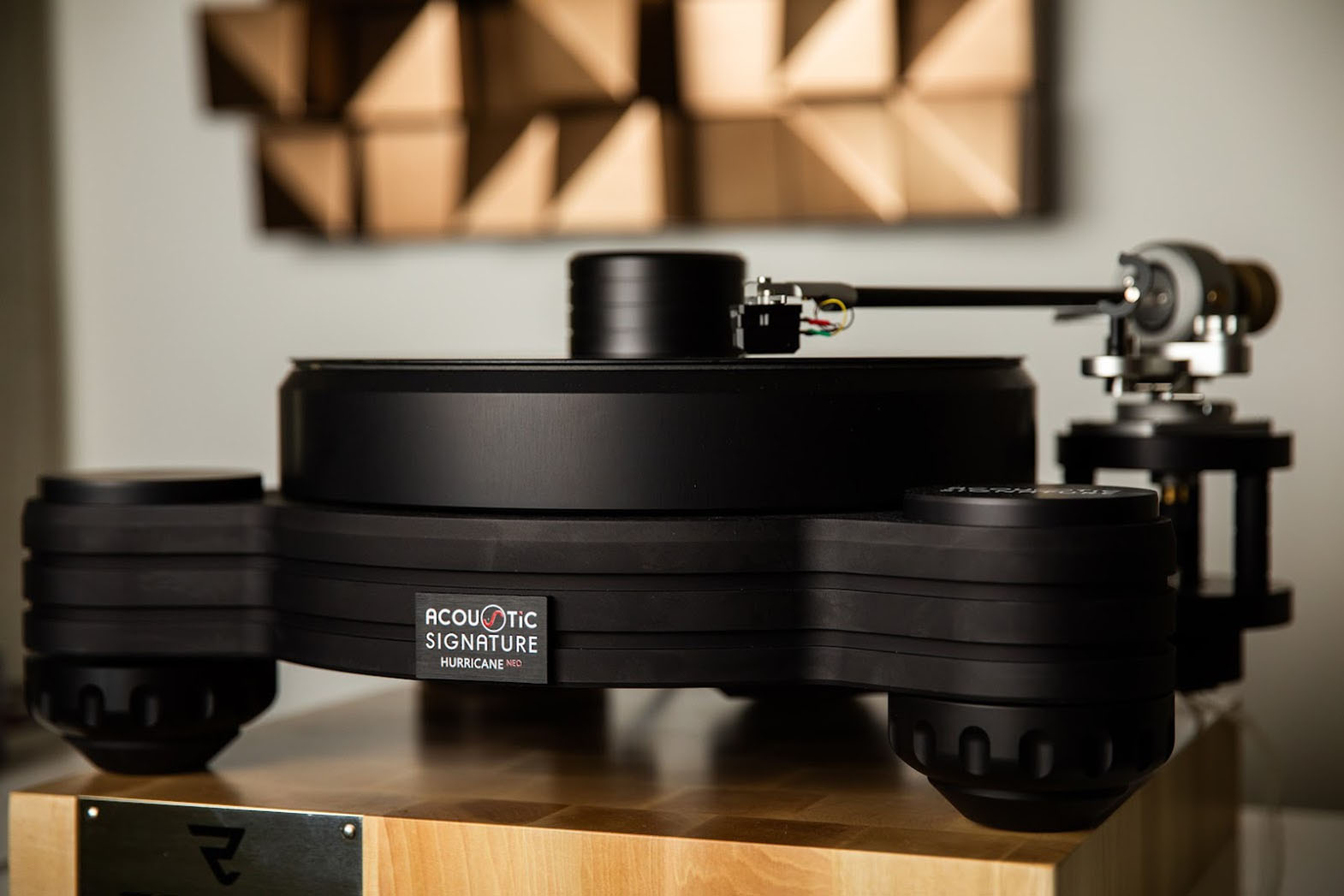
The “Analog vs. Digital” debate.
People have different tastes when it comes to music quality. Many audiophiles live by a code that only analog sound systems can produce the best music. The purists, connoisseurs of high-fidelity audio, believe that the best sound quality is made from analog equipment, just pure, unadulterated sound.
Digital music, on the other hand, is more about electronic equipment that alters and enhances audio quality, transforming it to create new sounds that regular instruments cannot reproduce.
Audio playback is always analog.
Regardless of the recording technique used, audio playback is always analog.
The audio playback is still analog whether you use speakers, headphones, or earphones. This is because audio is not discrete; it is a continuous wave of variations in sound pressure represented by changes in voltage. Seems like the flow of time. It is the flow of time sensed by our ears 🙂
Ultimately, we all hear „analog” signals, including all the subtle nuances and imperfections that make up a performance. And all those imperfections, non-measurable, random transitions are perfectly decoded by our brain. All this is connected to time because we can only sense time by tracking the infinitesimal changes in our surroundings through our senses.
In the Era of Streamers.
We live in the era of streamers, where digital has already conquered the world. There is still a revival of physical music formats going on, and it looks beyond pure nostalgia or fashion as a resistance movement. Hardcore audiophiles or just music lovers are returning to their roots and trying to escape the streaming reality. And why is that?
I have had a revealing experience lately, a truly shocking one. I am, in general, a tech lover and an advocate of the newest and greatest. I was one of those 99 percent, around 40, who have yet to hear proper vinyl records. My musical experience started with radio and has gone through cassettes and changed swiftly to CDs, as this was the most significant discovery of my generation. The holy grail of perfect reproduction, the escape from „analog” imperfection, and the unseen before of endurance of a physical format over time. After that, I was quickly conquered by the digital one and zeroes transferred by wires, thousands and thousands of kilometers. I had no other chance than to be a believer in the „streamer religion.” Until I recently heard a beautiful high-end analog vinyl chain with my ears. And then I understood the big fuss about full analog reproduction and why it is still so compelling to many people.
Don’t go through that rabbit hole!
No, I am not pushing you slowly, closer and closer to a vinyl rabbit hole. This „review” is still about digital transport and a streamer. But before revealing my motifs, I must set up the stage. So, bear with me just a little longer.
Another clue that I am on the right discovery path regarding the importance of time (timing) in musical reproduction came as a confirmation very recently. I attended the Warsaw Audio Video Show in October (you can read so much more about our adventure here, mostly a highly detailed analysis of my friend Sandu with strikes of colors from my side), and I witnessed an eye-opening demonstration in the Audio Group Denmark room. Lars Kristensen demoed their new streamer, and instead of showing a full-featured mobile app and large, colorful, and touchy screens, he started by playing vinyl. Say what? Yes, indeed.
The presentation started with Lars playing the remastered version of „The Beatles – A Hard Day’s Night” album, the beautiful „And I Love Her” song. Followed by another vinyl – the first press from 1964 of the same album. Needless to say, Lars also set up the stage to prove something. And when he pressed Play a third time to the digital source now, we all understood what the message was about…

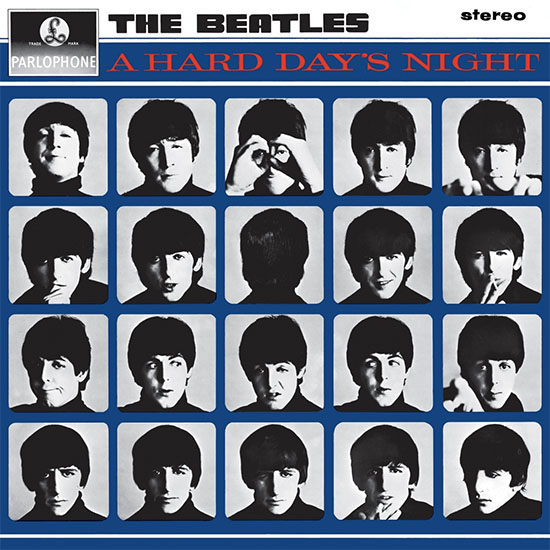
What did Lars try to demonstrate?
First of all, we had proof that „analog” reproduction is not perfect. Digital, done right, can build upon rather than destroy. Digital could bring something valuable to the table, come very close in the time domain, and improve in detail reproduction. Digital sources can be as close and natural as possible to the analog sound while contributing to the detail retrieval in the music. It is more reliable over time and much easier to preserve. But this quality is not easy to achieve and, most of the time, so damn expensive…
One thing is a fact – the pure analog is dying. Slowly but surely.
Secondly, the source matters more than the equipment. And by the source, I mean the mastering, the original source of the recording. It was so evident for everyone in that fully packed room at the show that the 1964 recording blew out of the water every other remastered version, analog or digital. The idea that digital could preserve those rare and pristine, unaltered recordings makes a lot of sense.
Thirdly, not all digital transports are the same. Well, we knew that… And again, it is all about timing. We listen to music by decoding the changes, and, as Lars put it, „we listen more to the transients,” to the before and after a note, than to the note (event) itself. Those spaces between the events are more important for our brains than we think. The timing is crucial.
3D LAB Nano Network Player Signature v5
with Nano Power 1
The main character can enter the stage now.
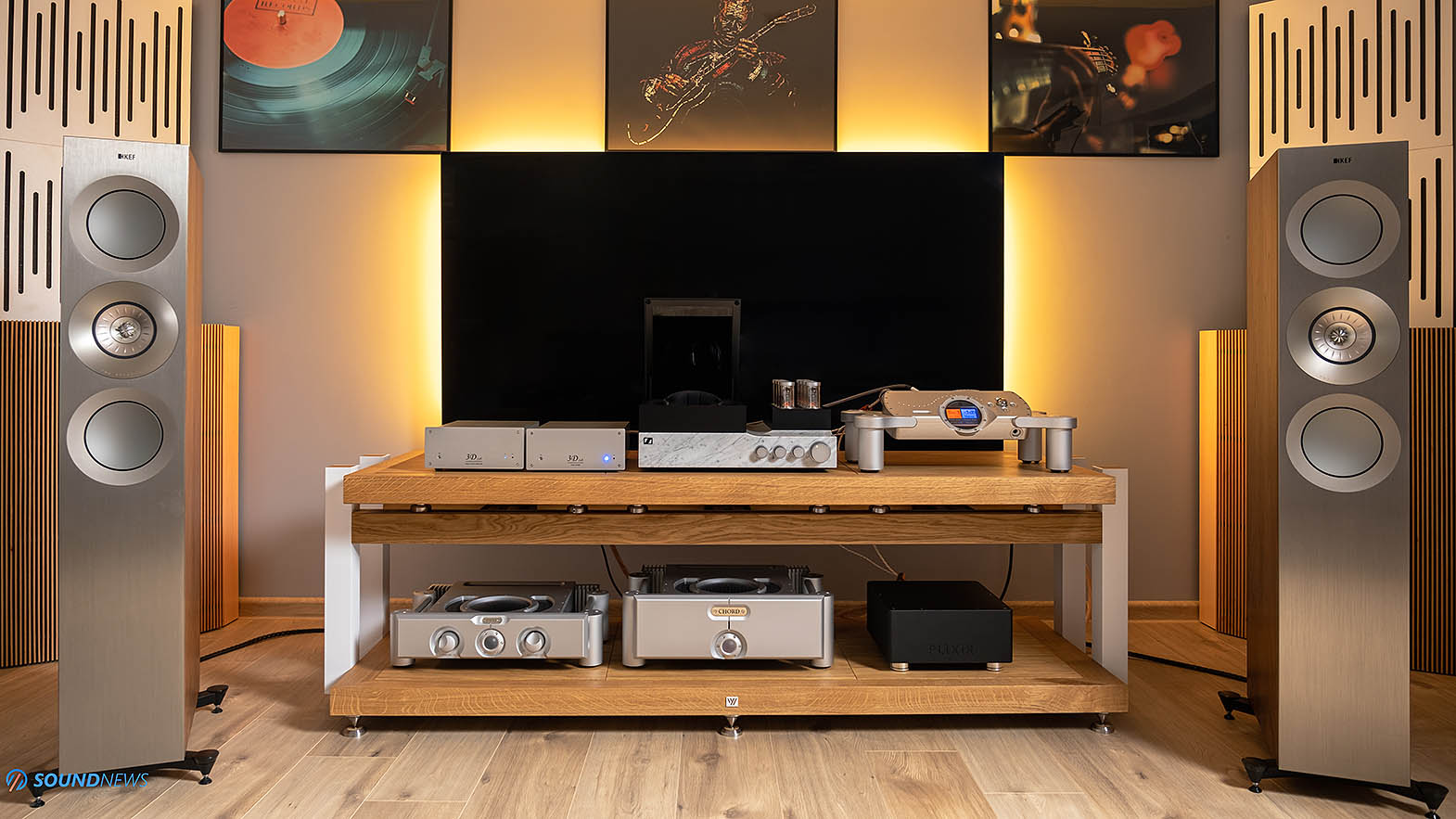
I know you can not spot immediately the real stars from this picture. You may think that Sennheiser HE-1 must be the protagonist. Well, not this time around (you can still see the review of the stunning HE-1 done by my friend Sandu here). Or look at the Chord shiny box on the right and think that it has to be about the time and precision of Dave DAC. Wrong, again, but you can also check a very detailed review of Chord DAVE if you like.
Which is it, then?
Our stars from today are those two inconspicuous metal boxes from the upper shelf on the left. Really? Yes, really. Sit tight and remember when your grandfather told you that „appearances are deceiving.” Because they are, and not just for physicists.
So, no bells and whistles?
None at all?
Yep. No flashy displays, no imposing black boxes, no lovely polished metal knobs, no fancy remote controls. That is it – two smallish aluminum boxes, one being the 3D LAB Nano Network Player Signature v5 and the other one, its power source Nano Power 1. I know you may be disappointed already, and I am counting on that! And it makes sense cause you cannot see the whole picture. Not just yet.
Let’s get a better perspective.
The version that landed to me for testing is the Player alternative. That means it is more than just a transport streamer. It also contains a DAC and can be used as a complete solution. Just add a power amplifier and two speakers. Yes, it even has a preamp in the digital domain, with well-regarded LEEDH processing.
Volume control is a very delicate subject because it destroys both analog and digital sound quality. The perfect sound is at 100% of the volume without attenuation in the signal path. By attenuating a signal, we cause a lessening of the dynamics, a loss of precision, and an increased distortion rate. LEEDH PROCESSING is an algorithm that repels signal degradation and, therefore, in regular use, does not cause signal modification. The result is spectacular; the music keeps its dynamics and precision.
If the DAC is unnecessary, one can also choose the transport-only version – 3D LAB Nano Network Transport Signature v5. I mainly tested the transport part as partnered with my Chord DAVE DAC and Chord Mscaler upsampler. The Nano Network Player Signature has a high-performance 32/768 PCM and DSD converter in 8X native mode. A jitter reduction and reclock circuit provide exceptional performance.
Many audio players or pure transports are generally PCs disguised as audio players. The noise generated by the high-frequency CPU and switching power supply in a typical computer is not a good option for quality audio players. It is well known that even the displays are polluting with EMI and electrical noise, so not using any was a conscious decision from 3D Lab.
Instead of a „normal” CPU, the Nano Player Signature uses a mighty FPGA with a linear power supply. This is all that we know from the manufacturer’s website. And the fact that it is equipped with a double clock with a phase noise below -173dB. And that in itself is pretty impressive.
To obtain the lowest possible noise and avoid having the main voltage (in my case, 230V) in the main box, the power supply ULNP: Ultra Low Noise Power Supply is split into two parts. A first box (Nano Power) lowers the voltage to 9 volts. A second very high-performance power supply is sitting in the streamer box and continues to adjust the voltage to the required values. Overall noise is therefore massively reduced. I discovered from the manufacturer’s documentation that „the power supply of the players uses very high-performance circuits to obtain noise levels never reached in the audio world. The power supply noise is 1µVRMS and 0.8µVRMS on Signature models.”
Also, there is something called Super Synchronization: thanks to the FPGA architecture, the number of floors and circuits is reduced to the minimum. The FPGA fulfills all the essential functions: receiver, transmitter, buffer, multiplexing, synchronization, noise, and jitter filtering. A single integrated circuit replaces all the usual necessary circuits.
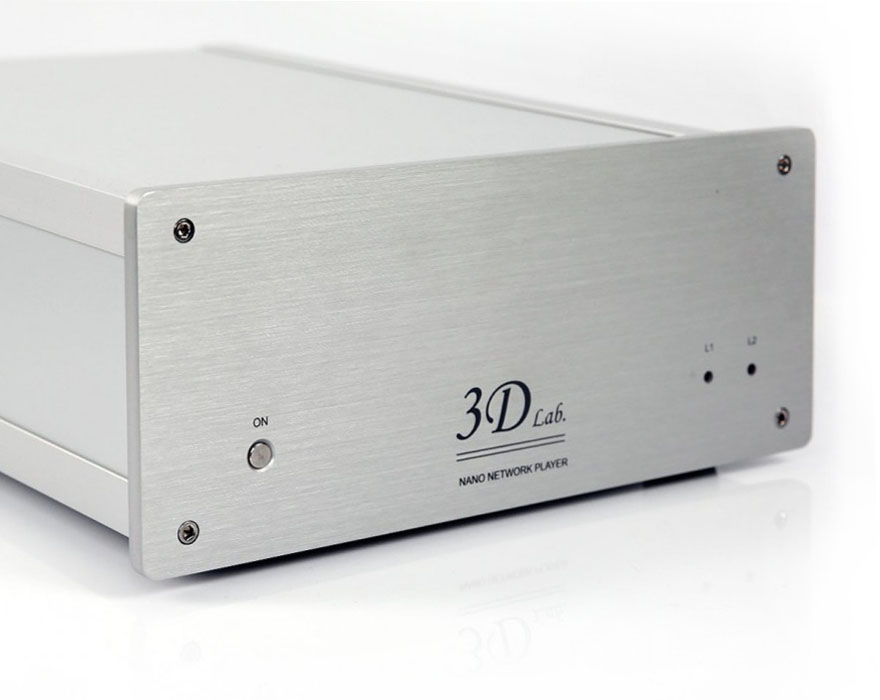
Are you ready for more?
I discovered another proprietary technology, Super Monitoring Flow, used to obtain the lowest possible jitter level. The FPGA enslaves a nano-computer that acts as an IP stack. Network flows are read by this nano-computer from local and internet networks. The audio stream is fully controlled and managed by the FPGA. In electronic language, the nanocomputer is the slave, the FPGA the master. In a classic architecture where the nano-computer is the master (almost the majority of solutions available on the market), the jitter rate on the I2S bus is 1,000 picoseconds. Thanks to this innovative technology (SMF), the rate collapses to only 36 picoseconds, which is colossal!
Other than that, it follows the functionality of any modern streamer: Gigabit network speed, it can decode a plethora of formats: PCM, WAV, DFF, DSF, AAC, FLAC, M4A, MP3, OGG, ALAC, WMA, AIFF, etc, it is Airplay compatible, Audirvana, Jriver, Qobuz, Tidal, Spotify, Roon, HQ Player, Squeezebox, and Bluetooth. Four USB sockets can be used for external storage, two USB 2 and two USB type 3. Wi-Fi connectivity can be obtained by a generic adaptor to a USB port.
Connectivity is assured by:
- 1 x RJ45 – Gigabit ethernet connection
- 4 USB sockets (2 x USB2 and 2 x USB3)
- 2 RCA analog outputs (Player version)
- SPDIF, TOS-LINK, and I2S
As for dimensions, they are 95 x 215 x 300 mm.
Open Home is also available for external CD playback with a ripping function and digital radio stations.
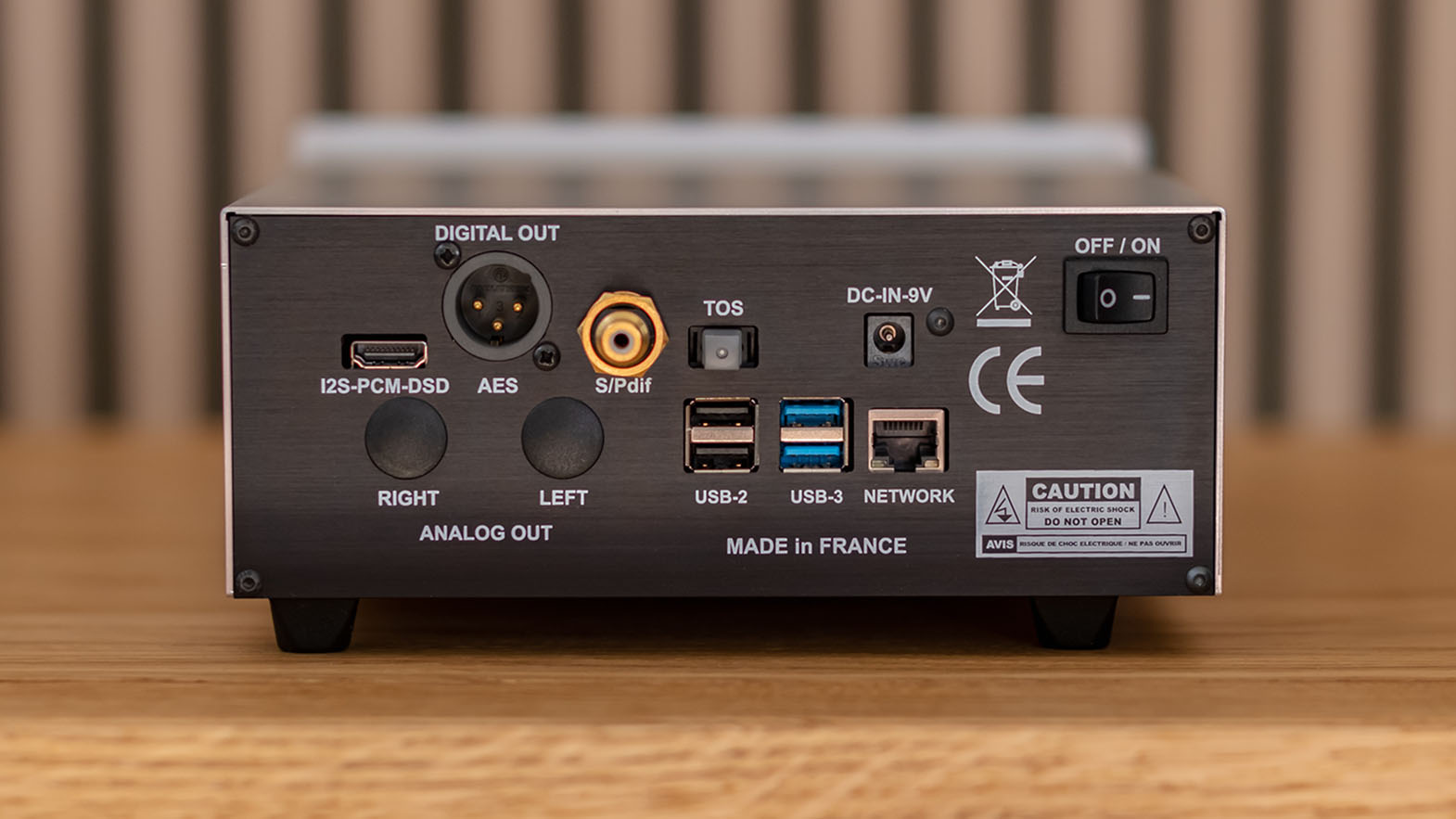
Any tablet, smartphone, PC, or Mac can control the Nano Player Signature. Since the system is entirely open, the possibilities are endless. Free choice is given to the customer. The user can install their software solution, free or not, but completely scalable: many solutions are available on PCs, Macs, and tablets (in iOS or Android).
Not quite what was expected from
2 small aluminum boxes?
OK, what did we get from all these technical details in plain language, free of all the gibberish? A lot more is happening behind the scenes…
Dual Power supply
The power – the essence of everything good in audio is exceptionally well sought. 3D LAB goes to great lengths to obtain the lowest noise levels.
Ultra Low Noise Clocking
The clocks used are of extraordinary precision, which will have a tremendous impact on the timing and reclocking of the signal.
FPGA and nanocomputer architecture
Separate network nanocomputer that feeds the powerful low-noise FPGA in a master-slave architecture, separating the signal processing from noise to reduce the jitter rate to incredible levels.
Super Synchronization
The I2S bus is perfectly synchronized, so the jitter is reduced again to a breaking record level never reached before. As for comparison, we have the measured jitter levels:
- An excellent CD player = 7,220 picoseconds
- A good network reader = 1,400 picoseconds
- A very good USB bus = 645 picoseconds (Amanero)
- A very good network player = 630 picoseconds (reclock the I2S bus)
- V3&4 3D Lab ( FPGA 3D-Lab) drives = 36 picoseconds
LEEDH volume control
It uses the most significant digital technology in volume control without losing dynamic and resolution.
Hard decisions.
In conclusion, today’s hero is a well-put-together piece of equipment. Nothing seems left to chance, and very hard-conscious decisions have been made by the 3D Lab. All of it is focusing on the sound quality alone. In a market full of glamourous streamers, 3D Lab ignores all those artificial and trendy directions and is betting all on exceptional sound quality. 3D Lab looks at the customer differently, empowering the user with the decision of usage scenarios and software choices by providing maximum versatility. And with great power comes great responsibility.
While others focus on wide, colorful, and touchy displays, 3D Lab puts all the effort into a highly sophisticated dual computing architecture, a very well-sought output stage, and perfect network isolation from noise.
Where others are connecting the streamer to a TV for fancy YouTube video playback by I2S/HDMI port but still using cheap switching power supplies, 3D Lab thinks hard of a dual linear power supply with the lowest noise floor in the industry, extremely precise clocks, and lowest jitter possible on the I2S buss.
Where others jump all in the boat of Android „off the shelf” platform software without second thoughts about updating and maintaining the software for years to come, at least from the security perspective, 3D Lab is looking at the customer as a partner for a long-term relationship, empowering the user with the software choice of its own.
Whereas others are trying, for better or worse, to develop fancy and, most of the time, buggy mobile apps to control their players, 3D Lab opens the doors for endless possibilities, again giving a choice to the user.
Whereas the market is flooded with new, slightly enhanced versions of the same product every few months, 3D Lab has been attentively developing one product architecture with clear steps with the level of performance expected now or in the future. The Signature edition is the highest level of the same product. The user can select the right cost/performance step (starting with Sonata and stepping up to Platinum and Signature levels, with or without a DAC). And, where others try to fill in all the imaginable functionalities into one product, 3D Lab gives customers a clear choice of buying only what they will actually need and use.
All those decisions are hard; it is not easy to focus on only one thing, one thing alone – the highest sound quality achievable at the respective price point. I am not blaming anyone, but I know it is a very tough market and difficult to not weaver. As always, my respect goes to the brave ones!
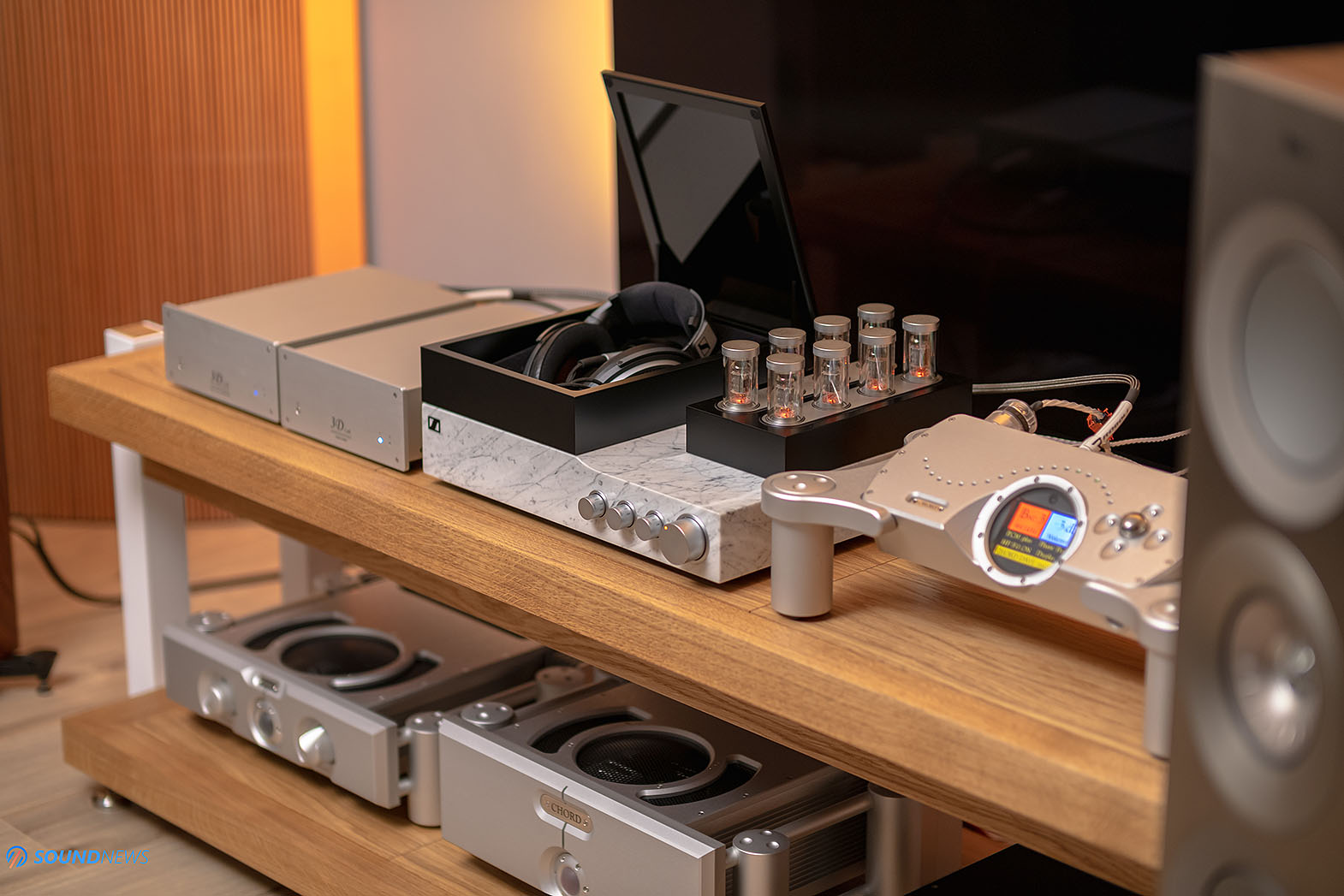
Sound Quality
Finally, we are here to witness what really counts. Let the play begin.
I am using Roon as a music server; this is my chosen streaming software platform. I am constantly trying to improve and overcome the inherent limitations. Every software is flawed, and many swear to one or the other streaming solution. I love Roon’s user interface and its bit-perfect signal path. That is why I used 3D Lab Signature only as a Roon endpoint for the whole listening session.
Testing equipment
I am trying to stay on a path regarding the software that I use. That is why I have gone to a great extent in building my server for the Roon core. One of the most essential parts of any equipment from the audio chain is the power supply. And if we are talking about the streaming in a server/endpoint configuration, please allow me to take a small step on the side.
New Farad Super10
While testing 3D Lab Signature Player, I had the chance to incorporate the new Farad Super10 power supply used to power the server part of the core/endpoint Roon configuration. I had experience with Farad’s Super3 power supplies before and was delighted with their sounds, form factor, and build quality. But this new beast (10 Amps) is at totally another level. Build quality is unprecedented, very far from what I have ever seen. The quality of the components and the well-sought of every detail is extraordinary. The capability of providing top-notch, effortless power without even breaking a sweat is mind-blowing. This is one of the pieces of equipment to get in a lifetime. Nothing, and I swear to you, nothing counts more in an audio chain than power. A detailed review will follow, and in the meantime, you can check the details here.
It is really worth having a look.
When the 3D Lab arrived with its high-quality power supply, it seemed like the stars aligned for a very smooth and assertive listening experience.
The Headphone Setup
- Custom build Roon server powered by Farad Super10
- Melco N100 streamer
- Chord Mscaler and Chord DAVE
- Trafomatic Primavera tube headphone amplifier
- HifiMan Susvara / Meze Elite
- Crystal Reference2 and Ultra2 power cables
- Crystal Reference2 XLR interconnects
- Melco S100/2 switch
The Speaker Setup
- The same custom build Roon server powered by Farad Super10
- Auralic Aries G2.1 streamer
- Auralic Vega DAC / Chord Mscaler + Chord DAVE
- Trafomatic EOS tube integrated amplifier
- Raidho TD 1.2 speakers
- A Charlin (Roboli) Red MK I power cables
- A Charlin (Roboli) XLR Blue 2100 MK II interconnects
- LHY SW-6 switch
3D LAB Nano Network Player Signature v5
in my Headphone Setup
Usually, I am trying to listen first in the headphone system. This way, I eliminate the room from the equation, at least initially. I already had an excellent streamer, so I never expected such a profound difference. It was so obvious right from the start.
Listening to Susvara and hoping to get the differences that I thought would be minute, I was set entirely aback by what I was hearing. It was one of those revelatory moments when I was even upset that there was such a big difference. I knew I could not afford another streaming escapade. First and foremost, the bass was extended more into the lows. How could that be? I heard a much deeper bass with more rumbling and incredible details. It was like I changed the headphones. I am sometimes a bass head, and this is my guilty pleasure. This time, I was hit in my sweet spot…
The highs were better defined and, at the same time, rounder and less aggressive. The upper registers were so much smoother and pleasant. Everything was better separated and sounded more organic. Those first impressions were shockingly good.
It sounded so fluid and natural that I forgot to change the track. I sat there listening to whatever Roon considered to feed me for a long time. I completely forgot to search for my prepared playlists. It was so revelatory that something of a much greater magnitude was happening. I could not initially put my finger on it, but after many hours of listening, the evidence started to pile up.
Frequency Response
I know this is a title for a headphone detail chapter. It was exactly like I changed the headphones, so indulge my sidetrack. I worked a lot on my network to gain speed and natural transients. I may be crazy, but I tried to extract the last drop of punch and naturalness from my headphone setup. 3D Lab changed in a second for good, more than I succeeded in months of fine-tuning.
The sound extended greater with a lot more authority. The bass notes were not just fuller but more detailed and extended lower. The midrange was sweeter, and all the voices were more pleasant and had a nicer timbre, more precise and organic sounding.
The highs were a lot more polished. The attack of the metallic instruments was more vivid without any trace of aggressivity. The sound flowed with lovely sparkles up top like falling stars on a beautiful summer night.
Dynamics, layering, and speed
Yes, everything was better, punchier, more natural sounding. The layering was more defined as the sounds extended on multiple dimensions with better speed and more natural transients. The decays linger more, and it seems that I know when the new puch will come; it was like I heard something before the time. It isn’t easy to describe the feeling of that natural flow of events.
I realized after a while that better dynamics and authority also came from speed. Better timing and faster transients will bring, first, better dynamics and, second, a more natural tonality. The flow was so correct, so palpable, and well structured.
I wrote a lot about the technical details, timing, and reclocking… I still can not understand how this enhancement could be of such magnitude. We are talking about a streamer, not a DAC. It is supposed to be a transport, a very accurate one preferably, but just a transport.
3D LAB Nano Network Player Signature v5
in an Exceptional Headphone Setup.
During the weeks of 3D Lab landing time, my friend Sandu got the incredible Sennheiser HE-1 in his place for a spin. I joined the party with 3D LAB Nano Network Transport Signature v5 to be used as the input source in that incredible setup. A TOTL streamer was required to get the most out of the Sennheiser ridiculously good headphone system. What a treat it was!
Just look at the picture and tell me that you are not stricken by the Nirvana-like euphoria state showing on Sandu’s face.
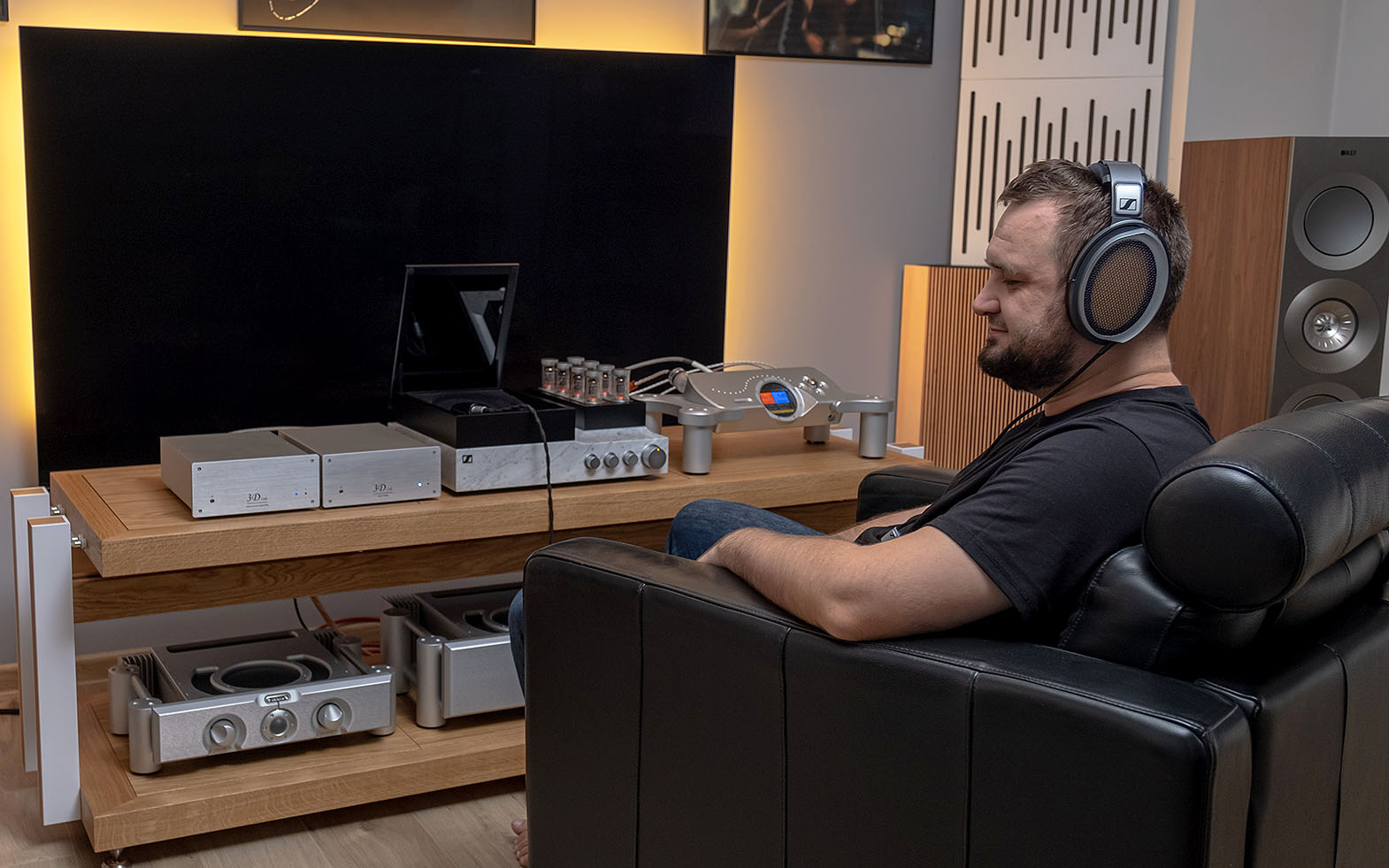
Right there, I realized the meaning of all the good stuff that we could hear so much better through the Sennheiser flagship. The rightful textured sound, reach in tone, and dimensionality are all tremendous attributes that speak about one thing and one thing only – the unique analog character of the 3D LAB Nano Network Signature v5.
This transport/streamer shaved off any trace of digital glare and beautifully preserved the details in a full-body and organic sound signature. I had a Déjà Vu moment of the beautiful vinyl experience that had not happened yet. Sure, it was not just about the transport; the whole chain sustained and enhanced the pure qualities of the music.
3D LAB Nano Network Player Signature v5
In my Speaker Setup.
I am back home from the „master of audiophilia retreat” at my good friend’s place.
It was the time to hear it in my speaker setup. I was afraid that the strong impression left by my friend’s supreme headphone system would cast a shadow on my speaker presentation. So, I tried to prepare the best I could: I moved the DAVE/Mscaler combo in the speaker chain, matched all the power cables, and generally tried to come as close as possible to a good and clean setup.
And it paid off. Right from the start, I left aside any trace of disappointment. Out of the woods now, I recognized again and even better the analog character, the system’s highly engaging and smooth presentation. Reach tonality, remarkable dynamic contrasts, and that whole expressive energy was there and even more.
Using speakers, we can discern other sound characteristics restricted by the headphones. Delightful spatiality, scene presentation, and 3D-like space are far easier to distinguish and appreciate in a speaker setup. Even the corporal dimensionality, the bloom, and the correctness of tonal expressions are more apparent.
I was impressed by the music’s vivid and lyrical hues and shades. The natural and effortless character was very present, and I recognized the speed and sweet flow from the headphone setup. Well-separated instruments, precise alignment on the stage, and the spatiality between the notes were delightful!
But most of all, the analog-sounding character, based on all those attributes, was the thing that stuck with me and made me wonder about the real purpose of digital transport and what is meaningful or not. The whole time, I used my phone or iPad to play music, and honestly, I never looked for a display from a distance. I was even complicity cozy with this minimalistic approach. I just enjoyed the music and forgot about everything else.
The most analog digital source?
Is 3D LAB Nano Network Signature v5 the most analog-sounding digital streamer? I would not venture into comparisons because I was so absorbed by the coherence and beautiful-sounding moments that I did not feel any need to do any A/B testing or comparisons.
It was the most analog-sounding streamer/transport I have heard. I have one exception, a big one from this year’s Warsaw show. But it is not about a streamer/transport; it is from another sphere of the universe… I hope to tell you more about it soon.
Is this a recommendation for everyone?
Well, no, definitely not.
First, the 3D Lab Nano Network Signature v5 is a blunt two-aluminum box you set up and forget about. This is not something to show off on your desktop or put on your glasses to look at proudly from your listening chair. It does not have a glamorous display, myriads of settings, or tons of useful or not add-ons. It has the sole purpose of gathering the ethernet digital stream, cleaning it up, reclocking it most perfectly, and passing it over to the DAC (unless one will not use the Player version) with the lowest noise floor in the industry.
Second, there is the price. It is not cheap by any means, but after spending a few weeks with this great piece of equipment, I am confident it is not expensive either. It definitely punches well above the price point in pure sound quality.
3D Lab Network Transport Signature v5 will get you a 3,450 Eur lighter in your pocket. If one desires the best power source, Nano Power 1 should add another 1,290 Eur to the table. The 3D Lab Network Player Signature v5 (with a DAC) will free you from 3,990 Eur.
In the right context, 3D Lab will spectacularly complete a well-sought system.
This streamer/transport/player is for the most conscious audiophile who cares only for the sound quality and cherishes a rich, highly dynamic, clean, detailed, and mostly the best analog sounding character from a digital source in the „Era of Streaming.” Who does not care about bells and whistles, is maniacally concerned about the minute negative influence of a display over the sound quality, and understands the qualities but mostly the downside of the digital religion.
This is for those who are courageous enough to keep it on their track. Those who understand the purpose and care less for passing trends and shiny boxes. Those who work hard to add every tiny improvement to their systems. Those who find the so-called law of diminishing returns meaningless.
This product is for the brave ones!
Wrapping Up
In the end, I have to admit that I am guilty. I looked very suspicious in the beginning. I found it dull and shabby in a world of colorful and shiny new stuff popping out every few months. I should have known better! The lack of fruitless aspirations should have been a clear sign of maturity and confidence.
Ultimately, I want to thank our local distributor for showing me what I can not see. Thank you, AV Store, for being such a reliable partner every time – https://www.avstore.ro
For everyone interested in 3D Lab products, check their website: https://www.3d-lab-av.com.
I was so impressed by the pure sound quality of this product that I had no other way of showing it but to issue another Gold Award from under my desk. As always, I am grateful to you all, and I hope for a word in the comment section below. Thank you, and happy listening until we meet again.




